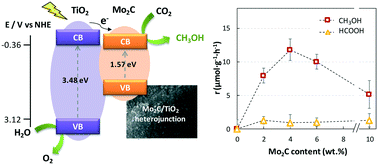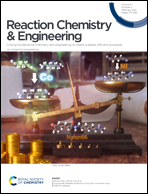Enhanced visible-light photoreduction of CO2 to methanol over Mo2C/TiO2 surfaces in an optofluidic microreactor
Abstract
Inspired by the photosynthesis process used by plants, the photocatalytic conversion of CO2 with water to obtain chemical energy can tackle increasing CO2 emissions and energy demand together. In this work, the performance of Mo2C/TiO2 blends in the continuous photocatalytic reduction of CO2 to methanol is evaluated in a micro-optofluidic reactor illuminated with UV and visible LED lights (5 mW cm−2). The photo-responsive Mo2C/TiO2 surfaces applied are manufactured by airbrushing a photocatalytic ink containing different weight percent (2–10%) of Mo2C nanoparticles (synthesized by a carbothermal method) and TiO2 (P25) onto porous carbon paper. Doping TiO2 with Mo2C makes the composite material active in the visible region compared with bare TiO2, while it does not bring performance enhancement when the photoactive surfaces are illuminated with UV light. A 4% Mo2C weight percent led to enhanced stable production of methanol under visible light (r = 11.8 μmol g−1 h−1, AQY = 0.21%, SCH3OH/HCOOH = 12.1), which is ascribed to the presence of Mo2C, able to extend the spectral response as well as reduce the recombination rate of photogenerated electrons and holes occurring in TiO2. Higher Mo2C contents, however, seem to shield the photoexcitation capacity of TiO2.

- This article is part of the themed collection: Emerging Investigator Series


 Please wait while we load your content...
Please wait while we load your content...